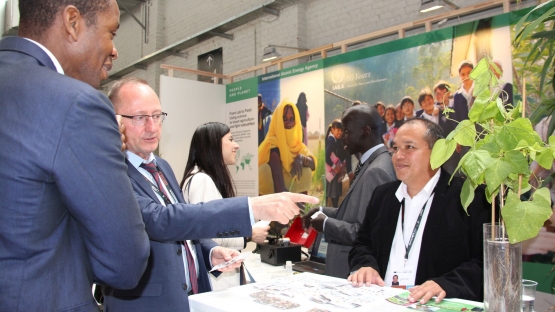This week, more than 6 000 development actors gathered in Brussels, Belgium, for the 11th edition of the European Development Days (EDD), organized by the European Commission. For the second year running, the IAEA is present at Europe’s leading forum on international cooperation, supporting the case for investing in development.
A visit to the IAEA’s exhibition stand, one of more than 75 stands at the event, gave conference goers a glimpse of the IAEA’s work around the world: Three countries and three stories illustrated how science is supporting development. In West Africa, farmers in Benin are reducing use of commercial fertilizer by growing pulses. In Sudan, scientific research is helping farmers to enhance agricultural water use efficiency. And policy makers in Latin America are improving their nutritional intervention programmes to fight childhood obesity.
Green, black and purple-brown – pulses, such as beans, peas and lentils come in a variety of colours and forms. Though beautiful in their simplicity, pulses are also powerful in many ways: They are beneficial to human health, easy and inexpensive to cultivate, and help to naturally fertilize the soil through their ability to fixate atmospheric nitrogen in their roots.
“Using a neutron probe sensor, a technology that measures water moisture content in the soil, scientists can precisely determine soil conditions. Farmers can then cultivate pulses to optimize crop and soil productivity”, explained Arsenio Toloza, scientist at the Joint FAO/IAEA Division's Soil and Water Management and Crop Nutrition Laboratory in Seibersdorf, Austria. He highlighted an example from Benin where farmers are managing soil fertility by planting pulses and significantly saving on fertilizer costs.
The IAEA stand aIso highlighted activities in Sudan, where local farmers have reduced agricultural water use while producing more food crops. Using isotopic techniques, Sudanese scientists can accurately determine moisture levels in soils, enabling farmers to understand and apply the exact amount of water needed by their plants.
Crossing to Latin America, childhood obesity is the focus of the IAEA projects illustrated. The concentration of the stable isotope deuterium in the human body informs on the amount of fat and fat free tissue. This information can indicate the risk of developing non-communicable diseases linked to overweight and obesity, and also the metabolic effects of food deprivation. Today, for example, around 18% of children and adolescents in the Latin America region are overweight or obese, often as a result of physical inactivity and transitioning diets.
“Using nuclear techniques, Chile was able to identify physical inactivity as one of the major drivers of the high rates of obesity in school children. Based on this knowledge a policy to promote physical activity in schools was formulated," said Victor Owino, nutrition scientist at the IAEA. “The number of children affected by obesity has reduced as a result.”
The EDDs are an important opportunity to showcase how the IAEA’s work is supporting Member States in achieving nine out of the 17 Sustainable Development Goals.
Using a neutron probe sensor, a technology that measures water moisture content in the soil, scientists can precisely determine soil conditions. Farmers can then cultivate pulses to optimize crop and soil productivity.





